Huawei P10 and P10 Plus: Performance & Battery Life Report
by Matt Humrick on May 12, 2017 7:00 AM ESTCPU & System Performance
The P10 and P10 Plus both use the same Kirin 960 SoC from HiSilicon as Huawei’s other flagship phone, the Mate 9. We already looked at Kirin 960’s performance and power efficiency in detail, and we also reviewed the Mate 9 earlier this year, so the two P10’s we’re testing now should not provide many surprises. The only outstanding questions are what type of RAM and NAND our units have, and do the P10s still perform the same as the larger Mate 9?
To evaluate overall system performance, we turn to the PCMark Work 2.0 suite, which tests the combined effects of the CPU, GPU, RAM, and NAND storage. Because it uses standard Android API calls and runs several different real-world workloads that elicit realistic behavior from the CPU governor (unlike synthetic tests that simply run one or more CPUs at max frequency), it’s a good indicator of everyday performance.
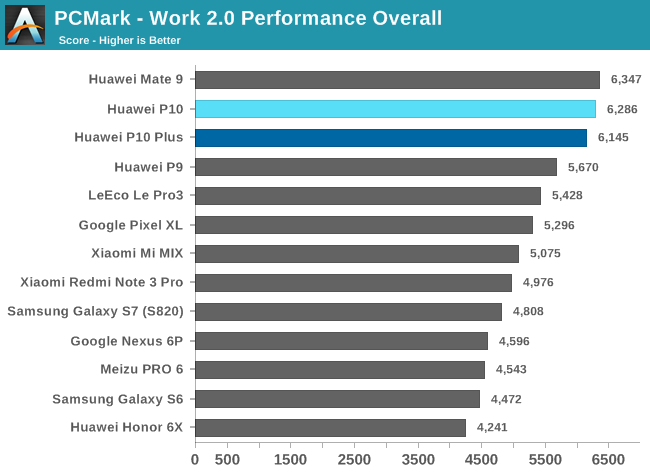
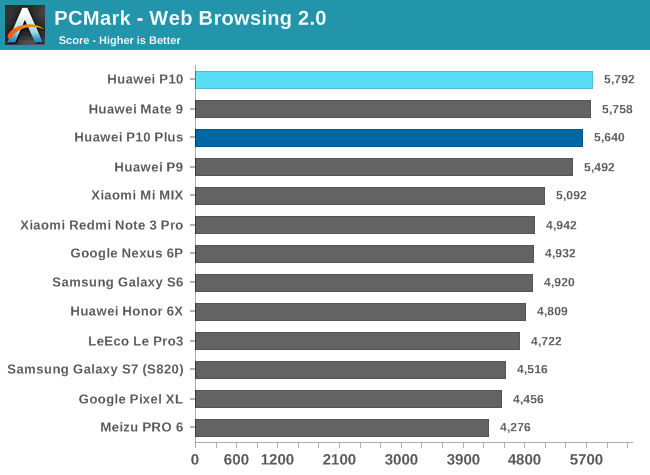
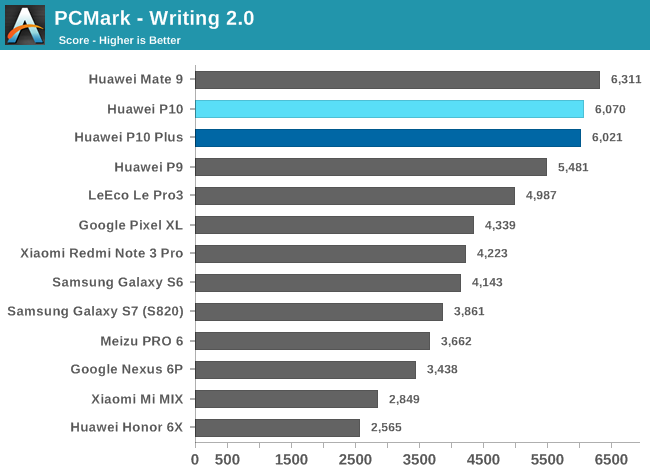
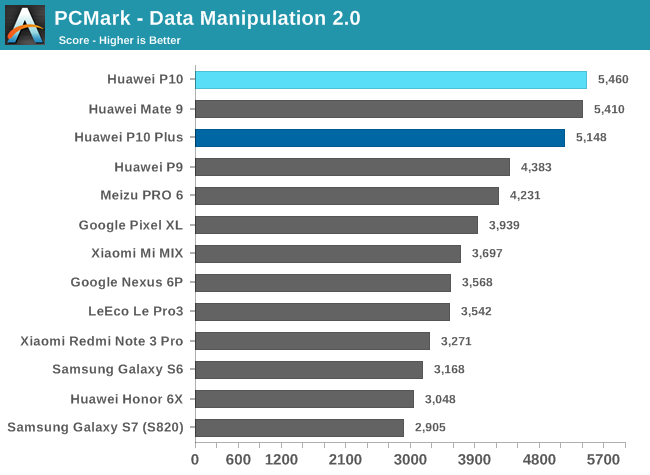
As expected, there’s no significant performance difference between the P10, P10 Plus, and Mate 9 in any of the PCMark Work 2.0 tests. All three phones post excellent results, with the P10 outperforming the older P9 and its Kirin 955 SoC by 11% overall.
There is not much difference between Huawei’s current generation flagships and last year’s P9 and Mate 8 in the Web Browsing test. The P10 Plus holds a slim 11% lead over Xiaomi’s Mi MIX and its Snapdragon 821 SoC, which grows to a more significant 27% lead over the Galaxy S7 and Pixel XL.
The Writing test is characterized by frequent but short bursts of activity that benefit from running on the big CPU cluster. While CPU IPC and frequency are important here, so is the phone’s proclivity to migrate threads onto the big cores. Huawei’s phones perform well once again in this test, with the P10 maintaining its roughly 11% advantage over the P9. There’s significantly more variation among the other phones in the chart, with the Mi MIX landing near the bottom at only half the performance of the P10. The Pixel XL trades places with the MIX in this test, but is still outperformed by the P10 by about 40%.
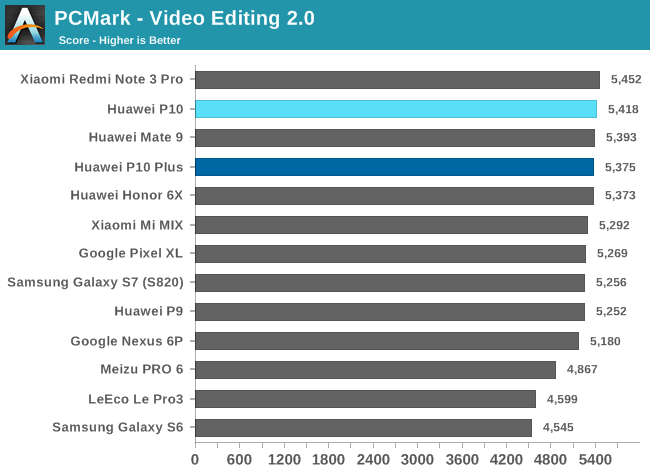
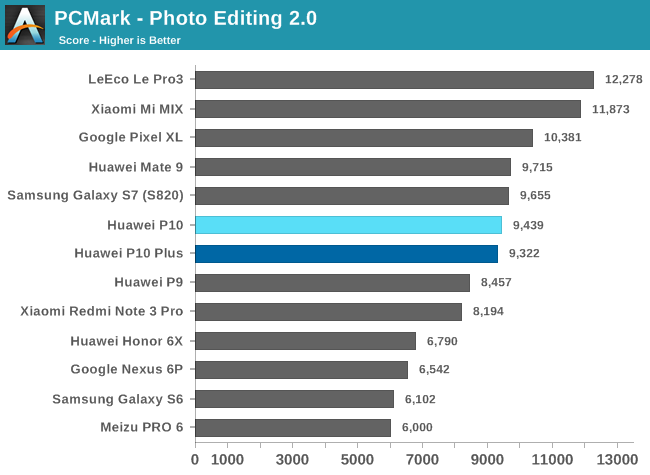
The PCMark Video Editing test is not particularly strenuous, so most phones perform about the same. The Photo Editing test, which uses both the CPU and GPU for applying various photo effects, produces more interesting results. It’s the only PCMark test where Huawei’s phones do not finish on top. Instead, phones using Snapdragon 820/821 SoCs and Qualcomm’s Adreno 530 GPU perform the best when running these workloads. The P10 holds a slim 12% advantage over the P9, but the Snapdragon 821 powered Le Pro3 is 30% faster.
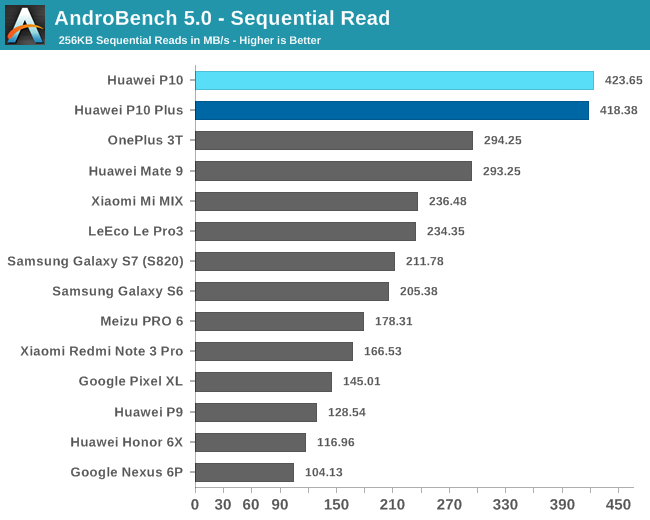
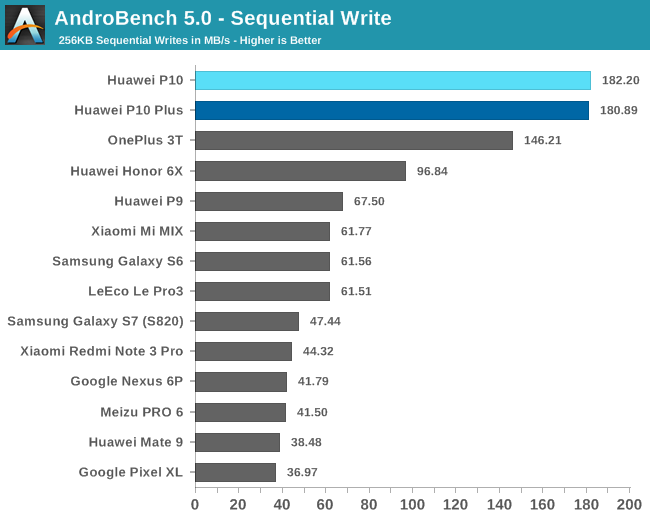
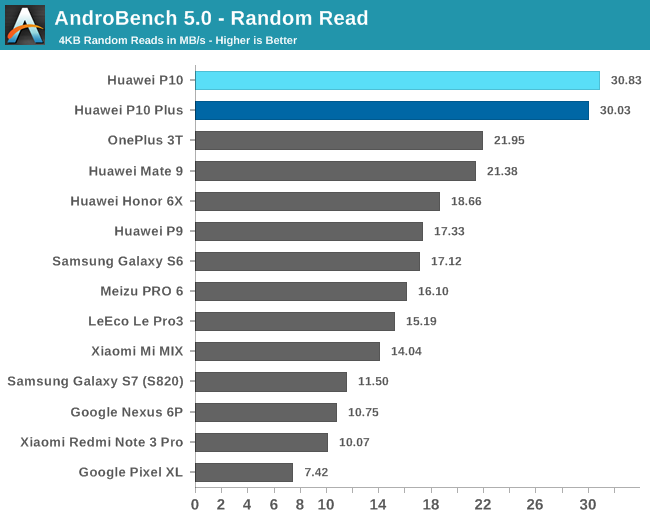
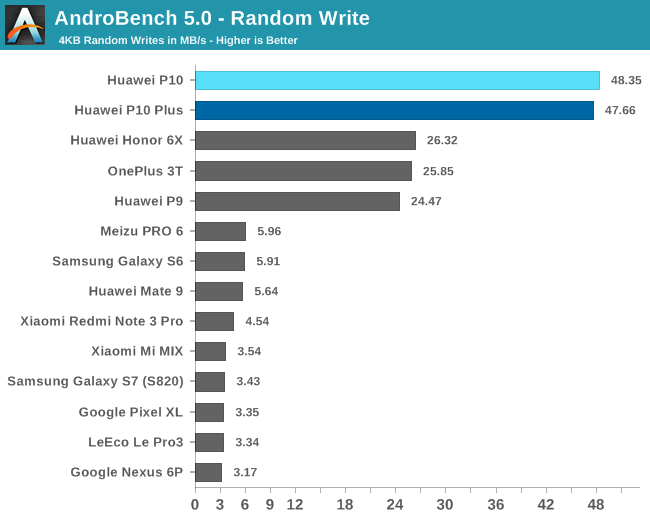
Obviously there is nothing wrong with storage performance for our P10s. Both the P10 and P10 Plus post excellent (and essentially identical) sequential and random throughput values. It’s also worth noting that both units are using UFS 2.0 NAND from Samsung.
The P10s easily outperform the Mate 9, especially when writing data sequentially or randomly. This particular Mate 9 is using UFS 2.0 NAND from Toshiba, which illustrates an important point: Just because a phone uses UFS 2.0 or 2.1 NAND does not mean it will perform well. Storage performance is multi-layered, starting with the operating system kernel and eventually ending at the storage controller and NAND itself. Even the underlying filesystem makes a big difference, with the P10, P10 Plus, P9, Mate 9, and OnePlus 3T all using the better performing F2FS (Flash-Friendly File System) for the /data partition instead of the default EXT4 file system.
With all of these variables in play, it’s impossible to even say that UFS NAND is always faster than eMMC NAND. For example, the Huawei P9, which uses eMMC 5.1 NAND, outperforms the newer Pixel XL and its UFS NAND in all but the sequential read test. The P9 also outperforms the Mate 9 in both writing tests. Now this does not mean a P10 with eMMC 5.1 NAND would perform the same or better than the two UFS examples we tested (it would not be able to match the sequential numbers at least), but it is important to take a step back and see the bigger picture.
| Storage Performance (AndroBench 5.0) | ||||||||
| Seq. Read (KB) |
Seq. Write (KB) |
Random Read (KB) |
Random Write (KB) |
|||||
| 1024 | 2048 | 1024 | 2048 | 8 | 16 | 8 | 16 | |
| Huawei P10 | 499.35 | 541.97 | 185.50 | 185.18 | 55.73 | 96.00 | 84.86 | 139.32 |
| Huawei P10 Plus | 516.78 | 558.45 | 182.24 | 183.15 | 53.22 | 93.37 | 82.52 | 137.51 |
| Huawei Mate 9 | 429.17 | 480.07 | 74.60 | 100.01 | 38.81 | 66.27 | 10.77 | 16.99 |
| Huawei Honor 8 | 169.07 | 198.77 | 83.65 | 102.45 | 30.2 | 46.25 | 17.17 | 26.59 |
The table above shows how storage performance scales with larger IO sizes. While the values we use in our general tests above represent the most common IO sizes, other workloads, notably accessing media files like photos and video, will utilize larger IO transfers, so it’s important to see how a phone performs over a wider range of scenarios. Sequential read throughput for the P10s continues to scale as expected, maintaining their lead over the Mate 9. Sequential write performance does not scale any further and only maintains its already high values. The Honor 8, which uses eMMC 5.1 NAND like the P9, manages to outperform the Mate 9 when writing sequentially or randomly at any IO size.
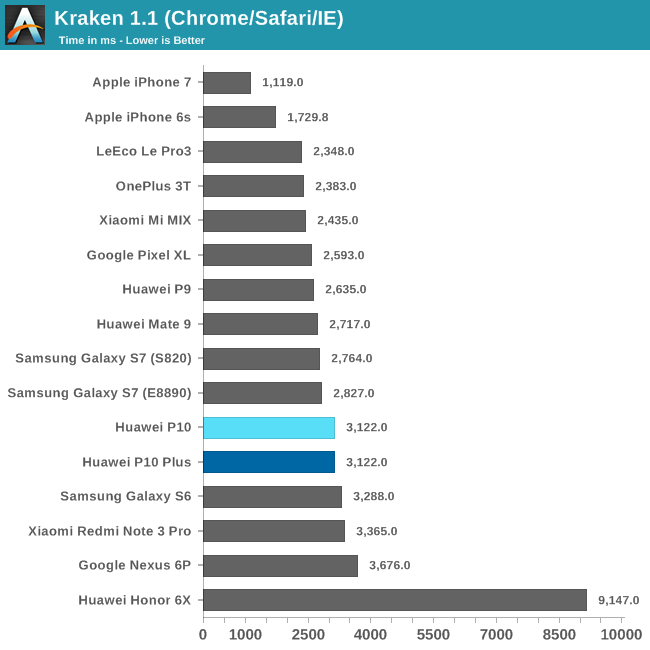
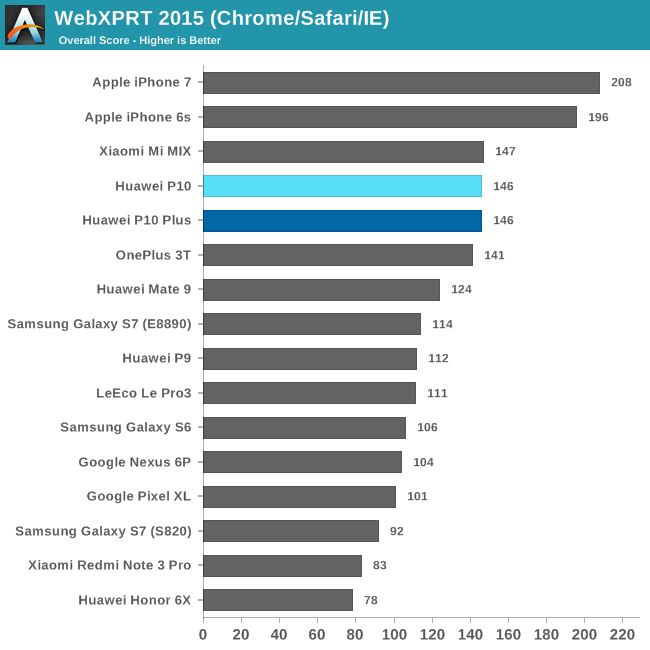
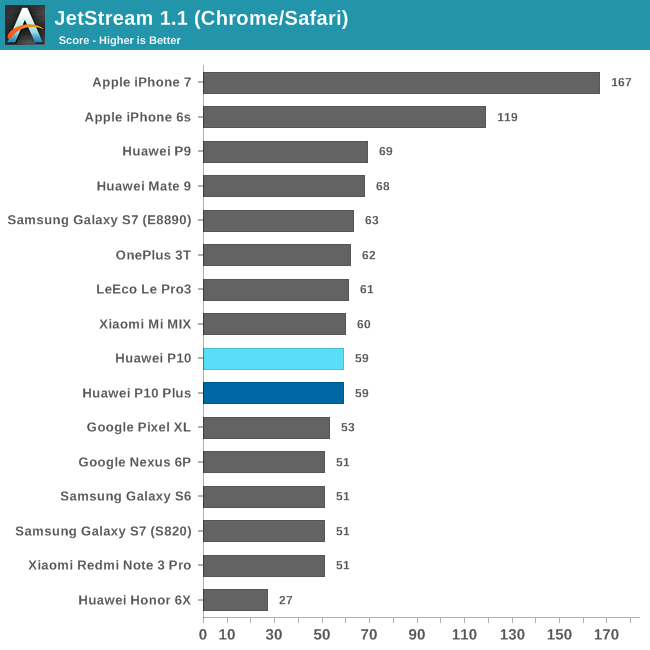
In the Kraken JavaScript test, both P10s fall behind the Mate 9 by 15%. The P10’s A73 CPU cores also cannot match the performance of the higher frequency A72s in the P9’s Kirin 955 SoC, or the custom Kryo cores in the Snapdragon 820/821 devices. The P10s do outperform the less-expensive Honor 6X by a factor of three, highlighting the performance deficit of using octa-core A53 CPU configurations instead of pairing the A53 cluster with 2-4 big out-of-order CPU cores.
Finishing positions flip in WebXPRT 2015, with the P10s out in front of the Mate 9 by 18% and the P9 by 30%. Scores in JetStream show less variation, but the P10s fall behind the Mate 9 and P9 once again by 17%.
The tests above corroborate my own subjective experience with the P10: It’s fast. Common tasks such as installing or opening apps, switching between running apps, and searching through my email inbox complete quickly. The redesigned EMUI 5.1 UI is smooth and responsive—not Pixel XL smooth, but flagship smooth.










74 Comments
View All Comments
philehidiot - Friday, May 12, 2017 - link
Another review site did come to this conclusion. I think the issue is that the smartphone has hit perfection in many ways, just like the old T9 based phones of old. There's only so far you can go with a form factor before something new has to come along. Samsung is trying with it's display (as is LG) but frankly I don't give a crap about HDR on my phone screen. I do care about HDR on my TV or PC monitor but that's because I'll sit and watch a film on it. If you're watching a film on a smartphone, you're likely on a train or somewhere where the ambient lighting is going to be more of an issue than the dynamic range of the screen. I just don't see the hardware formula going anywhere anytime soon unless someone comes out with something completely different. They are all merging on the same kind of platform. Google has the software in hand so there's little to differentiate on, unless you're a bunch of idiots and think that Bixby has a chance up against the might of Google.... why, Samsung, why waste the resources?!Stochastic - Friday, May 12, 2017 - link
Samsung's displays really are better than everyone else's, though: http://www.displaymate.com/Galaxy_S8_ShootOut_01.h...That's the kind of performance I'd be willing to pay a premium for.
Meteor2 - Saturday, May 13, 2017 - link
...crap speakers though. I want a picture which looks good -- but also a sound which sounds good.Meteor2 - Saturday, May 13, 2017 - link
"I think the issue is that the smartphone has hit perfection in many ways, just like the old T9 based phones of old."That's a good way of thinking of it, though I think/hope there's room for improvement in battery life and performance. But with the A73 being more of a sideways move compared to the A72, despite being very different, I do wonder if we're reaching a limit.
philehidiot - Wednesday, May 24, 2017 - link
I think we're reaching a limit in terms of what you can do with the form factor that's going to vastly improve the user experience. I'm sure there will be little things here and there but from what I feel, they're now just ensuring you have to upgrade every couple of years in order to maintain the user experience. I am on an S810 based phone and there is absolutely no reason why this should struggle with normal use at all yet just recently (just before the S835 was released), updates came along which introduced vast amounts of lag. The solution? Well I'm sure it's to upgrade to ensure I once again have smooth performance. You don't get anything really new, you're paying a fortune for the basics to remain the same and for incremental improvements which don't really make a massive difference. If it wasn't for the battery life being dire and the introduction of poorly optimised software creating issues which didn't need to be there, would I upgrade? Probably not.As it stands I'm left with little choice due to the tyranny of planned obsolescence and it seems to me that they want nearly a grand every two years to tread water in many respects.
amdwilliam1985 - Friday, May 12, 2017 - link
I agree with most of the posts here in regards to false advertising, Huawei is ruining their newly built reputation, it's a huge NOT recommend from me to any of my friends & families.I understand there are supply shortages(other OEMs do too), so I would much prefer if they advertise the P10 phones with eMMC 5.1 & LPDDR3 @ lower price points, then reviewers report people getting UFS & LPDDR4(icing on the cake with lucky draws).
On a separate topic, why is it that Huawei and OnePlus are using F2FS, but Samsung and the other didn't? As far as I can tell and read, F2FS was created by Samsung and it basically gives you "free" performance.
serendip - Friday, May 12, 2017 - link
On the other hand, phones with slower RAM and NAND might have lower power consumption. I'd be wary of Huawei's advertising and pricing though; it's obscene to charge flagship prices for EMMC storage. Maybe they could do block 1 or block 2 variant pricing so users know which hardware they're getting.Stochastic - Friday, May 12, 2017 - link
I thought UFS and LPDDR4 were also more power efficient?Eden-K121D - Friday, May 12, 2017 - link
UFS LPDDR4/X are more efficient so you're going to get worse battery life on the shitty phonesphilehidiot - Wednesday, May 24, 2017 - link
They could do what LG did with the G5 - they had a version with a slower SoC but the same screen and camera set up and sold it cheaper. Probably had slower RAM and so in as well. For many people that makes a lot of sense as the top tier chips are only slightly better for general use and really a bit of a waste if you don't game or do a fair bit of video / photo editing.